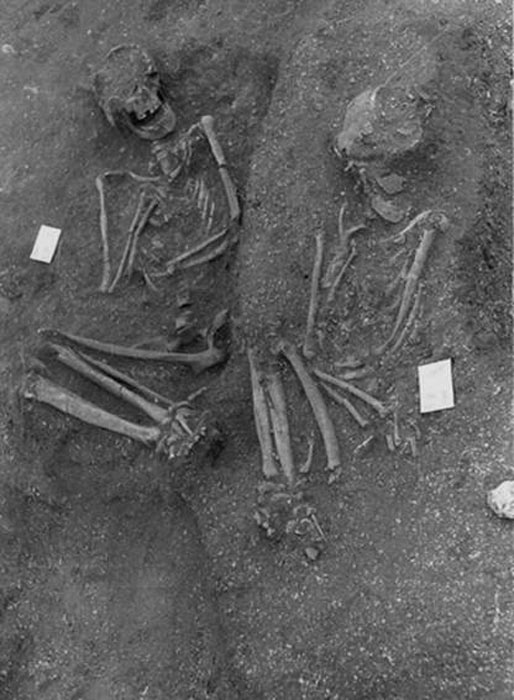Mesolithic Burials in Europe from 8,000 Years Ago Point to Earliest Evidence of Mummification
How old is the art of embalming the dead and where did it originate? This is one of those eternal archaeological questions that is constantly reinforced and altered with the arrival of new evidence.
In the realm of popular history, mummification has been associated with the ancient Egyptian civilization and the grand pharaohs of yesteryear, but the Chinese, the ancient people of the Canary Islands, the Guanches, and many pre-Columbian societies of South America engaged in this practice.
A new study published in the European Journal of Archaeology has found human remains from 8,000 years ago in the Sado Valley in Portugal, emerging as the oldest and first evidence of Mesolithic mummification in Europe.

A Brief History of Mummification
In terms of dating though, this is now officially the oldest evidence of mummification anywhere in the world, surpassing the deliberate mummification of the Chinchorro mummies found in the Atacama desert in Chile dated to 7,000 years ago, or Egypt, where the earliest evidence is from 5,600 years ago.
The study was conducted by Uppsala University, Linnaeus University, and the Universidade de Lisboa in Portugal.
“Our study combines archaeothanatological analysis with insights from experimental taphonomic research, thus adding a new dimension to our understanding of Mesolithic mortuary practices.
Here we present what we believe to be evidence for intentional mummification and reflect on attitudes to the body and the handling of the dead, including their transport to significant places in the landscape,” wrote a multi-national team of researchers led by archaeologist Rita Peyroteo-Stjerna of Uppsala University in Sweden.

These finds suggest that European Mesolithic people were performing practices such as desiccation through mummification at sites like the Sado Valley much earlier than previously thought.
Heritage Daily reports that most mummy finds range from between 4,000 years ago up until a few hundred years ago. This find is at least double that average, and with proof of intentional treating and drying before burial, it comes across as a burial ritual that has never been demonstrated before in the European Stone Age, added Stjerna.
The Challenge of Studying Mesolithic Mummies and the Science Employed
The challenge of studying mummies has been manifold – at one level, soft parts of the body, or the soft tissues, are rarely preserved, and there is a lack of written and historical sources. With the decomposition of the soft tissue, traces of the preservative treatment used are unclear, particularly in temperate and humid climates. Thus, in European climates, the preservation of soft tissues and textiles is very difficult, as per a press release by Uppsala University, which is quoting lead co-author Liv Nilsson Stutz from Linnaeus University.
Recently rediscovered photographs from the Sado Valley, Portugal, from the 1960s reveal the burial style of Mesolithic tombs in shellfish banks, which have shown how dead bodies were laid and buried. The study combines archeothanatology, a method that, like a forensic field investigation, documents and analyzes the spatial location of the bones at the time of the excavation, supplemented along with the results of an experimental study of mummification and burial of human bodies which was conducted at Texas State University.

Amongst the key observations, one was the peculiar positioning of the legs in the grave – a position with ‘strongly bent extremities, an absence of disarticulations of certain significant parts of the skeleton, and a rapid filling of sediment around the legs,’ says the press release.
“For hyper flexed positions to be present in a burial with preserved labile joint connections in unstable positions, the body must have been initially buried in this hyper flexed position. The combination of hyperflexion throughout the body with a lack of disarticulation or evidence of in situ bone movement, as observed in Arapouco 1962, unknown 3, is, therefore, a strong taphonomic indicator of burial in a mummified condition,” the researchers write in the study.

These patterns were perhaps the results of a guided natural mummification process, taking place over a period of time, wherein the body gradually desiccated to maintain bodily integrity. Simultaneously, a contraction by trussing with ropes and bandages brought the compression into a more desired position, making transportation easier. At the same time, the burial would allow for the dignity of retaining the individual’s appearance and anatomical integrity.
Burials: A Cultural Relic
For a long time, the burials have been considered unremarkable and no different from the norm. The photographs themselves had faced the ravages of time, and the disinterred remains were moved to the National Museum of Archaeology. Along with the poor-quality photographs, sketches and a limited follow-up of the study were also taken and left with the remains.

With the death of archaeologist Manuel Farinha dos Santos, three rolls of films were recovered from his private collection – these film rolls were connected to the excavations carried out in the sites called Poças de S. Bento in 1960 and Arapouco in 1962. The images from his private collection turned out to be immaculate, allowing the research team to conduct a more in-depth archaeothanatological analysis than had been possible previously, reports Science Alert.
This has allowed us to further explore the possibilities of prehistoric burials and see how the progression of death rituals has carried on through human history. After all, the rituals surrounding life and death remain one of the most crucial identifiable cultural markers, particularly because every group of human beings has different ways of commemorating the same, across time periods.